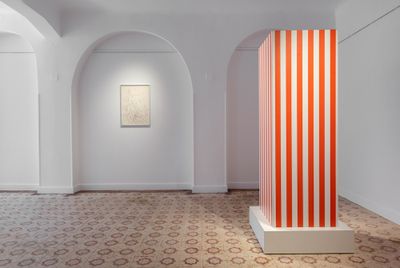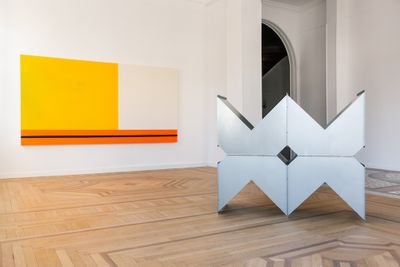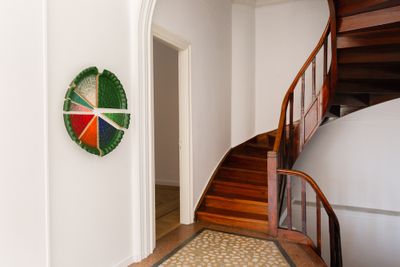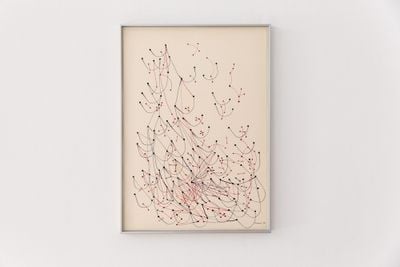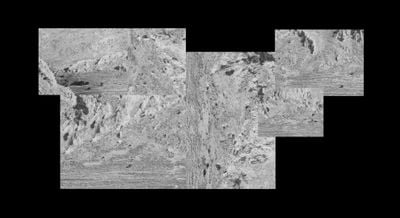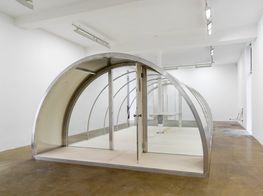Learning From Doxiadis: Object Lessons in Athens
Amid rumours of new lockdowns following increasing Covid-19 cases in Athens, the sense that my house is a cell has returned. From social bubbles to distances, different cells are being created every day, whether outside, at home, or in digital space.
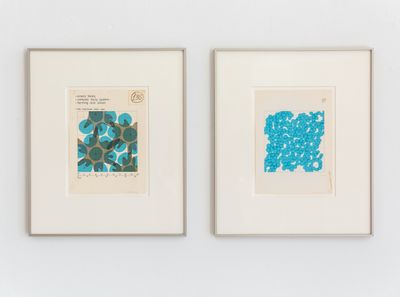
Constantinos A. Doxiadis, Kinetic Fields – Complex Daily System – Farming and Urban – The machines take over (c. 1968–1970). 28 x 21 cm; Kinetic Fields – Simple Daily Systems – Farming covers the whole area (c. 1968–1970). 28 x 21 cm (left to right). Exhibition view: Fate of a Cell, Martinos Pandrossou, Athens (10 September–7 November 2020). Courtesy Constantinos and Emma Doxiadis Foundation. Photo: Paris Tavitian.
But even before the pandemic, apps and social networks helped track our movements and connections. This reality makes the visionary work of 20th-century Greek architect and town planner Constantinos A. Doxiadis feel all the more relevant.
A leading public administrator during Europe's reconstruction period after World War II, Doxiadis played an important role in urban planning in postwar Greece and de-colonised countries like Pakistan and Lebanon. His theory of Ekistics—which broke down human settlements into a complex system of five elements—nature, man, society, shells (buildings), and networks—proposed a new model for metropolitan growth that incorporated ideas like technology, and the organic nature of life on earth.
The design drawings and diagrams that Doxiadis used in his architectural and urbanistic studies as well as his theoretical texts, were an important link between his ideas and the objects he produced, giving visual-symbolic form to the conceptual systems that interpreted relations in space.
Two of these designs, Kinetic Fields – Simple Daily Systems – Farming covers the whole area and Kinetic Fields – Complex Daily System – Farming and Urban – The machines take over (both c. 1968–1970) are the starting point of Fate of a Cell, a group show organised by Andreas Melas at Martinos Pandrossou, Athens (10 September–7 November 2020), to explore the networked nature of cells.
Presented as fragments in this exhibition, though, Doxiadis's colourful diagrams of overlapping blue globules cannot be understood as forming part of a larger unit of designs provoked by the evolution of technology and the creation of roads of different scales in farming areas, but rather as aestheticised visual 'notes'.
Their juxtaposition with mainly abstract geometric sculptures and paintings by nine other artists encourages mainly visual connections, whether Ettore Sottsass' white and orange striped Superbox Cabinet (1969–1970), a symbolic, ritualistic take on an everyday object, or Peter Halley's painting White Cell with Conduit (1986), a minimalistic comment on the supposed neutrality of capitalism's networks.
The result is an academic study on form rather than an extension of Doxiadis's theory into new fields. While Lena Henke's personal and affective anti-patriarchal gaze on urban planning and theory could open an interesting dialogue with Doxiadis's coding of human behaviour into the city, for example, her glazed ceramic cakes—circular green fields cut like pie-charts (2018 and NOW, both 2020)—acquire a more descriptive character as sensual illustrations of cellular units.
Similarly, Oscar Tuazon's network of sculptural steel and threaded rods circling a marble column, A Doorway (2011–2012), does not bring forth the environmental activism in Tuazon's work, which criticises the way natural resources are exploited and unequally distributed.
A more poetic approach to the grid and the concepts of systems and structures is present in Bia Davou's untitled linear ink drawings of 'circuits' from 1975–1978, with lines and dots drawing from the formal vocabulary of computer flowcharts and the Fibonacci sequence.
The obsessively repetitive mental and manual processing in Davou's diagrams find a point of relation in Charlotte Posenenske's galvanised sheet steel tube sculpture Vierkantrohre Serie D, T-piece (ramification) x 4 (1967–2016), whose four pieces can be combined to create any number of configurations. Both artists attempt to demystify the uniqueness of the art object in order to underscore the object's potential to expand.
Aristide Antonas' two notefilms no Zabrinskie, no point. Element A. desertcell and no Zabrinskie, no point. Element B. desertcell (both 2020) provide a much-needed trigger to open up Fate of a Cell's formal perspective to broader matters. Juxtaposed with a moving collage of geological formations referencing images of Death Valley in Michelangelo Antonioni's seminal 1970 film Zabriskie Point, is a scrolling text connecting the act of stepping back to thinking with the world of things (in short: reality).
Doxiadis understood the role of the architect as a creator of evolving communities rather than as a designer of objects. In keeping with this organic approach, he suggested that the theory of cities should be in dialogue with ecology and politics.
With climate change, humanitarian crises, state violence, and a global pandemic urging populations across the world to think about space as a commons inhabited by visible and invisible communities, Doxiadis's call for systemic balance provides much needed food for thought.—[O]




